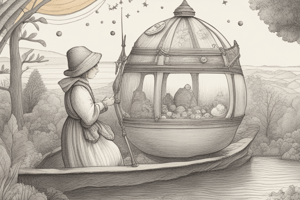Podcast
Questions and Answers
What is the primary composition of the Sun?
What is the primary composition of the Sun?
- Carbon and Iron
- Helium and Neon
- Hydrogen and Helium (correct)
- Oxygen and Nitrogen
Which planets are classified as terrestrial?
Which planets are classified as terrestrial?
- Eris, Pluto, Haumea, Makemake
- Jupiter, Saturn, Uranus, Neptune
- Mercury, Venus, Earth, Mars (correct)
- Venus, Earth, Saturn, Jupiter
What defines a dwarf planet?
What defines a dwarf planet?
- A body that is a satellite of a planet
- A body that is large enough to be rounded by its own gravity but not to clear its orbit (correct)
- A planet that is composed mainly of gas
- A body that can clear its orbit of other debris
Which of the following is NOT an effect of solar activity?
Which of the following is NOT an effect of solar activity?
Where are most asteroids located in the Solar System?
Where are most asteroids located in the Solar System?
Which of the following planets is categorized as a jovian planet?
Which of the following planets is categorized as a jovian planet?
What characteristic do comets have as they approach the Sun?
What characteristic do comets have as they approach the Sun?
What is the central body of the Solar System primarily responsible for its mass?
What is the central body of the Solar System primarily responsible for its mass?
What is the primary theory explaining the formation of the Solar System?
What is the primary theory explaining the formation of the Solar System?
What is one significant effect of our Moon on Earth?
What is one significant effect of our Moon on Earth?
Flashcards
Solar System
Solar System
The gravitationally bound system consisting of the Sun and all the objects that orbit it.
Planets
Planets
Large celestial bodies orbiting a star, which are broadly categorized as terrestrial (rocky) or jovian (gaseous).
Terrestrial Planets
Terrestrial Planets
The four inner, smaller, rocky planets: Mercury, Venus, Earth, and Mars.
Jovian Planets
Jovian Planets
Signup and view all the flashcards
Dwarf Planets
Dwarf Planets
Signup and view all the flashcards
Sun
Sun
Signup and view all the flashcards
Solar Nebula Hypothesis
Solar Nebula Hypothesis
Signup and view all the flashcards
Moon (natural satellite)
Moon (natural satellite)
Signup and view all the flashcards
Asteroids
Asteroids
Signup and view all the flashcards
Comets
Comets
Signup and view all the flashcards
Study Notes
General Overview
- The Solar System is a gravitationally bound system comprising the Sun and the objects that orbit it.
- These objects include planets, dwarf planets, moons, asteroids, comets, and other smaller bodies.
- The Sun is the central and most massive object, accounting for over 99.86% of the system's total mass.
- The planets orbit the Sun in roughly the same plane, called the ecliptic plane.
- The Solar System's formation began roughly 4.6 billion years ago.
The Sun
- The Sun is a G-type main-sequence star.
- It is composed primarily of hydrogen and helium.
- Nuclear fusion in its core converts hydrogen to helium, releasing enormous amounts of energy.
- This energy is emitted as electromagnetic radiation, including light and heat.
- Solar activity includes sunspots, solar flares, and coronal mass ejections, which can affect Earth's magnetosphere.
Planets
- The Solar System has eight planets, categorized as either terrestrial or jovian.
- Terrestrial planets (closest to the Sun) are relatively small, rocky, and dense: Mercury, Venus, Earth, and Mars.
- Jovian planets (farther from the Sun) are large, gaseous, and have faint rings: Jupiter, Saturn, Uranus, and Neptune.
- Each planet has unique characteristics in terms of size, composition, atmosphere, and orbital period.
Dwarf Planets
- Dwarf planets are celestial bodies that orbit the Sun and possess enough mass to be rounded by their own gravity, but not enough to have cleared their neighboring regions of planetesimals.
- Examples include Pluto, Eris, Makemake, and Haumea.
Moons (Natural Satellites)
- Many planets have moons or natural satellites orbiting them.
- Moons vary greatly in size, composition, and geological activity.
- Some moons, notably those of Jupiter and Saturn, have complex surfaces and may even harbor subsurface oceans.
- Our Moon is an example of a natural satellite that has significantly influenced Earth's tides and, possibly, its habitability.
Asteroids and Comets
- Asteroids are rocky or metallic bodies that orbit the Sun.
- Most asteroids are found in the asteroid belt between Mars and Jupiter.
- Comets are icy bodies that orbit the Sun with elongated trajectories.
- As comets approach the Sun, their ices vaporize, creating spectacular tails that point away from the Sun.
Formation of the Solar System
- The leading theory for the Solar System's formation is the solar nebula hypothesis.
- This theory suggests that the Solar System formed from a rotating cloud of gas and dust called a solar nebula.
- Gravity caused the nebula to collapse, and the material concentrated at the center to form the Sun.
- The remaining material formed a disk around the Sun, where planets formed.
Studying That Suits You
Use AI to generate personalized quizzes and flashcards to suit your learning preferences.





